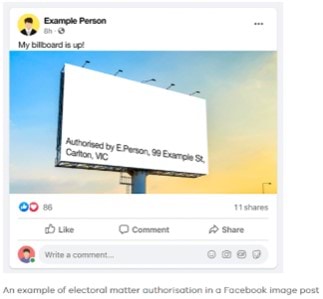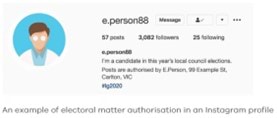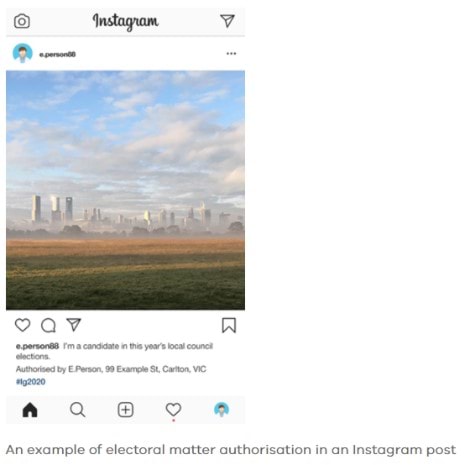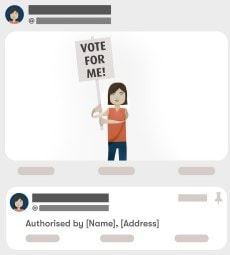Electoral material, defined as an advertisement, handbill, pamphlet or notice that contains electoral matter, requires authorisation. The material can be in the form of either printed material, social media or in electronic format.
Electoral matter means matter that is intended or likely to affect voting in an election and includes an express or implicit reference to or comment on an election, a candidate in an election or an issue before voters in connection with an election.
Authorisation ensures transparency and allows someone to decide for themselves how much they value or trust electoral material.
The requirement to authorise all electoral material is an ongoing requirement, not just during an election period.
Authorising electoral material
Authorising electoral material requires the name and address of the person who authorised the electoral material being clearly displayed on its face.
The address can be a street address or a Post Office Box. It cannot be an email address. The person who authorises electoral material must be a person aged 18 years or older.
Material that requires authorisation
Electoral material can take many forms, including:
- billboards, posters, corflutes and signs
- a ‘how to vote’ card
- paid and unpaid print, digital and online advertising
- social media posts and profiles
- websites, including dedicated websites
- electronic communications, such as SMS and emails
It does not include:
- Car stickers, items of clothing, lapel buttons and badges, fridge magnets, pens, pencils and balloons
- An advertisement in a newspaper that is only announcing the holding of a meeting
Definition of materials
Advertisement – anything that is made or intended to draw the attention of the public, or a section of the public, to a particular person, thing, event or movement. An advertisement can appear in many forms, including online, by spoken, written or printed words, pictorial representation, light or sound, or by exhibition to the public. The subjective intention of the maker of the material is not relevant in determining if it is an advertisement.
Handbill – printed electoral material delivered or distributed by hand.
Pamphlet – a printed document, which would ordinarily be available publicly.
Notice – an item that conveys a brief piece of information to the public or a section of the public, by written or printed word. A notice may be accompanied by an image. A notice does not include audio or a moving visual image, such as a video or a digital media file.
Who must authorise electoral material?
Any person printing, publishing or distributing electoral material must include the relevant authorisation on the material.
It is not only candidates that print, publish and distribute electoral material – any individual, group or organisation can print, publish or distribute electoral material and must include the relevant authorisation on the material.
Circumstances in which a person is ‘printing, publishing or distributing’ electoral material (or causing the same) include:
- causing electoral material to appear on an electronic billboard, electric road sign or other similar device
- posting electoral material on a website or social media platform accessible by the public or a section of the public
- sending electoral material to a group (or groups) of strangers by electronic transmission, such as an email, text message, messaging application or social media
Where electoral material is deliberately separated from its authorisation statement, and proximity between the electoral material and its authorisation no longer exists, the person who prints, publishes or distributes the separated electoral material must authorise it.
A candidate can authorise their own electoral material.
What must be included in an authorisation statement?
Electoral material must include the name and address of the person who authorised the material. This person must be a natural person 18 years or older. It cannot be a body corporate (e.g. a political party, company or organisation).
Name requirements
Electoral material must include the name of the person who authorised the material. A person may use:
- an initial and surname (e.g. S Williams instead of Sarah Williams)
- a commonly accepted variation of their name, including an abbreviation or an alternative form of their name (e.g. Tom instead of Thomas)
- a name they are commonly known by, but that is not their legal name, provided they are publicly known by the name
A social media account name, username or handle is not a name.
Address requirements
Electoral material must include the address of the person who authorised the material. The address can be a geographical address (typically a street address and suburb) or a PO Box.
It cannot be an email address.
While the address should be the person’s usual address, it does not need to be a residential address. It can include the address of an office, such as a company or business address, or the address of an election campaign office.
Language requirements
The authorisation statement must be in accordance with the following language requirements:
- if the electoral material is only in English – the authorisation statement must be in English
- if the electoral material is in a language other than English – the authorisation statement must be in both English and the language used in the material
- if the electoral material is in two or more languages – the authorisation statement must be in English and all other languages used in the material
Format requirements
The authorisation statement must be formatted in a way that ensures it is reasonably prominent.
The authorisation must:
- be legible at the distance at which the electoral campaign material is intended to be read
- be in a text that contrasts with the background on which the authorisation statement appears
- be printed in a way that the authorisation statement will not fade, run or rub off
- not be placed over backgrounds that detrimentally impact its legibility (e.g. complex pictorial or multi-coloured backgrounds)
Authorisation of social media content
Electoral campaign material that appears on social media platforms must still be properly authorised with the name and address of the person authorising the material.
The diversity and changing nature of available online platforms prevents the LGI from providing exhaustive examples of authorisations for all social media platforms.
The LGI has, however, created examples of authorisations for various platforms to outline its expectations with respect to the authorisation of electoral material on social media.
Each individual post that is posted by a candidate, or related party, must contain an authorisation. An authorisation is required for each post, so that the authorisation is transferred, with any posts that are shared beyond the candidate’s social media account(s).
Examples of how to comply with the Act’s authorisation requirements when using social media
The LGI considers an authorisation statement must be present in both:
- The Facebook profile which contains electoral material:

2. The text or image of any Facebook post which contains election material:


The LGI considers an authorisation statement must be present in both:
- The Instagram profile which contains electoral material:

2. The image of any Instagram post which contains electoral material:

X (formerly known as Twitter)
The LGI considers an authorisation statement must be present in both:
- The X profile which contains electoral materials:

Source: Victorian Electoral Commission
2. The image of any X post which contains electoral material. A photo of video can have the authorisation imbedded in it to meet the requirements of the Act.

Source: Victorian Electoral Commission
Updated

